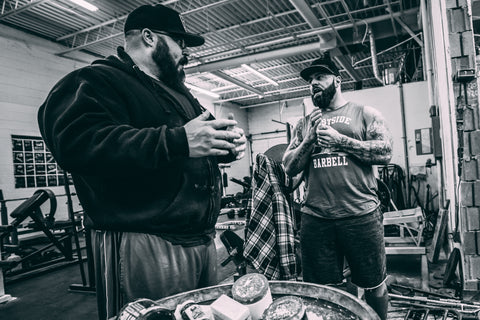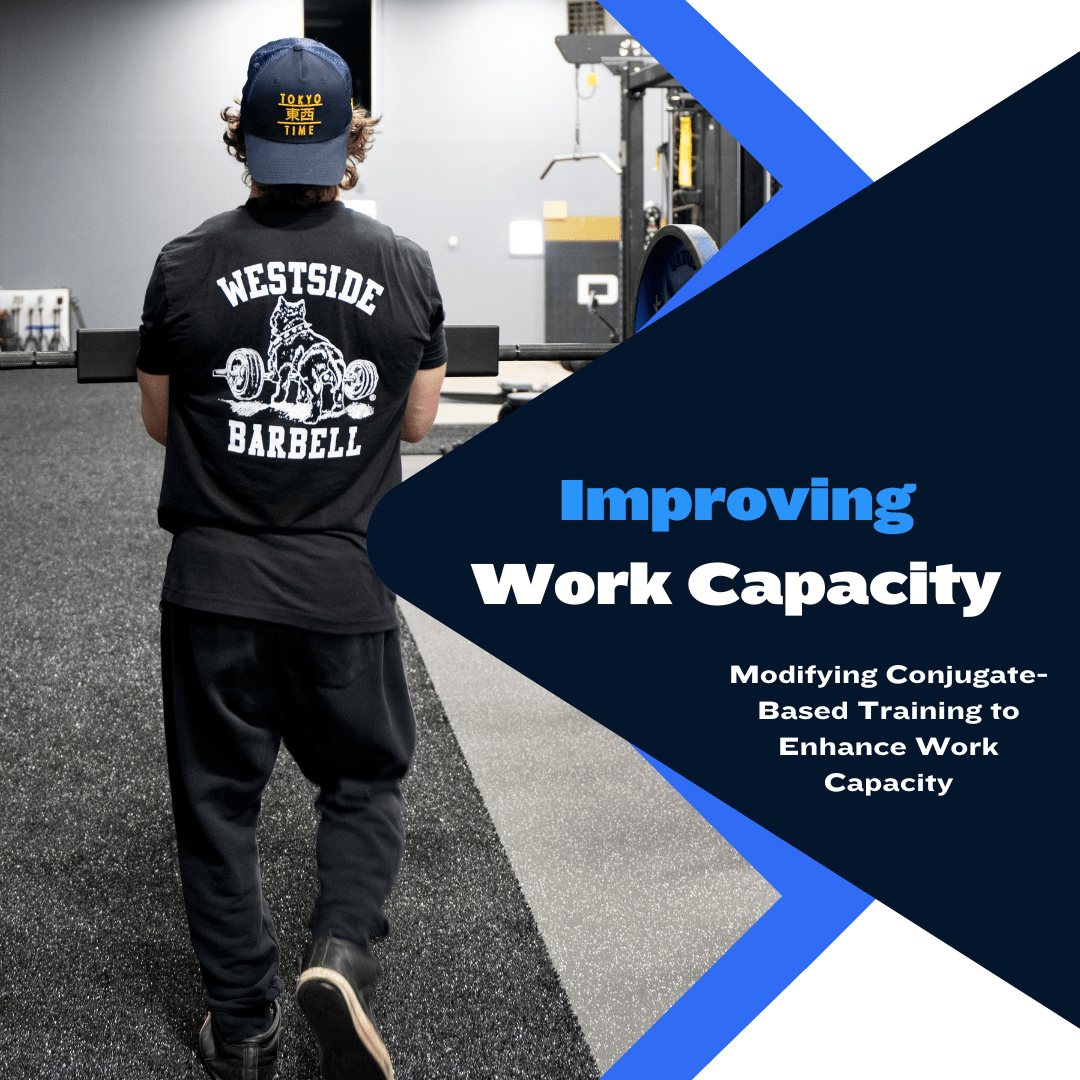Improving Work Capacity

Possessing the ability to perform a sport-related task for an extended period is crucial for all athletes. No matter the sport, athletes must be able to perform at a high level for the duration of the competition. An athlete with this ability will outperform their competition simply by remaining capable of keeping the pressure on their opponent.
At Westside Barbell, we have long understood the benefit of building our athletes' work capacity. By using repeated effort and various conditioning methods, we have consistently developed athletes capable of performing sport-related tasks at a high level over an extended period of time.
The Conjugate Method builds absolute and explosive strength via the max and dynamic effort methods. The repeated effort method aims to deliver ideal levels of hypertrophy, target weak points, and build work capacity. In addition to these three methods, we also add a conditioning component to each workout to ensure both anaerobic and aerobic abilities are improved. This is the proper approach to enhancing work capacity.
If we want our athletes to be capable of adequately displaying their absolute and explosive strength abilities in competition, we must ensure they have the gas tank to do so. This makes the Conjugate Method the premier training method for all athletes - the ability to improve multiple special strengths and athletic traits simultaneously.
Below, we will review a few simple approaches to enhancing work capacity to ensure athletes have the gas tank necessary to display their absolute and explosive strength abilities to the fullest extent during practice or competition.
Training Volume and Density
When aiming to enhance work capacity, we first need to address training volume and density. This will primarily affect our approach to dynamic and repeated effort training, considering max effort training must be executed with the specific intent to achieve the overall goal of the training - lift the heaviest weight possible for the day. However, with dynamic and repeated effort training, we can manipulate training volume and rest times to help improve work capacity.
At Westside Barbell, our volume prescriptions for dynamic effort training range from moderate to high. We follow a three-week wave pattern during dynamic effort training, with the volume starting at a high level and tapering to a moderate level over the three weeks as training intensity slightly increases. This alone will help an athlete improve work capacity.
We can take it a step further by limiting rest times between sets during dynamic effort main exercises. The approach here is simple: We want to take only enough rest time between sets to ensure the next set can be completed safely and to standard. This means no breakdowns in technique and no reduction in barbell velocity.
However, with repeated effort accessory exercises, we have a few more options. First, it is essential to note that accessory exercise volume will always depend on the demands placed on the athlete by their current practice and competition schedule. Ensuring the accessory exercise volume delivers ideal training stimulus with optimal training outcomes without causing excess fatigue that hinders sports performance is critical.
To improve work capacity with accessory exercises, we can increase the training volume, change exercise selections to focus on conditioning, utilize supersets, and limit rest times between sets. We will sometimes employ all the above to improve work capacity, provided the athlete's fitness level and sports schedule allow it.

Enhancing Work Capacity: Dynamic Effort
The dynamic effort method features considerable training volume, which is ideal for enhancing work capacity. However, as mentioned above, we can manipulate rest times to further focus on improving work capacity. Here is how we recommend programming both a 12 x 2 / 10 x 2 / 8 x 2 and a 5 x 5 training wave during dynamic effort lower:
Standard Wave:
Week 1
12 x 2 @75% (50% bar weight + 25% AR), 45 seconds rest between sets.
Week 2
10 x 2 @80% (55% bar weight + 25% AR), 45 seconds rest between sets.
Week 3
8 x 2 @85% (60% bar weight + 25% AR), 60 seconds rest between sets.
Enhanced Volume Wave:
Week 1
5 x 5 @70% (45% bar weight + 25% AR), 60 seconds rest between sets.
Week 2
5 x 5 @75% (50% bar weight + 25% AR), 60 seconds rest between sets.
Week 3
5 x 5 @80% (55% bar weight + 25% AR), 90 seconds rest between sets
When it comes to selecting a wave scheme, it all depends on the athlete's fitness. We typically recommend the standard wave for beginners and intermediate athletes. The enhanced volume wave can deliver tremendous results for advanced athletes. Ultimately, the wave you choose will depend on the individual's ability, current level of fatigue, and current sport and competition schedule.
Enhancing Work Capacity: Accessory Exercises
Utilizing accessory exercise training to enhance work capacity allows an athlete to improve their work capacity each training day. Once the main exercise is completed to the standard of the day (max or dynamic effort), we can manipulate our accessory exercise selection and execution to impact work capacity positively. Here is how we recommend programming accessory exercises accessory exercises to enhance work capacity:
Upper Body Accessory Training:
Primary Accessory Exercise
Push Press - 4 x 5-8, 60-90 seconds rest between sets depending on training intensity. AMRAP on last set.
Secondary Accessory Exercises
Rolling DB Tricep Extension - 4 x 10-12, 45-60 seconds between sets.
Lat Pulldown - 4 x 10-12
(SUPERSET)
Tricep Cable Pressdown - 4 x 10-12, 45-60 seconds rest between supersets.
Hammer Curl - 4 x 12-15
(SUPERSET)
Standing DB Lateral Raise - 4 x 12-15, 45 seconds rest between supersets.
Lower Body Accessory Training:
Primary Accessory Exercise
Romanian Deadlift - 4 x 5-8, 60-90 seconds rest between sets depending on training intensity. AMRAP on last set.
Secondary Accessory Exercises
Inverse Curl - 4 x 10-12 or AMRAP, 45-60 seconds between sets.
Goblet Squat - 3 x 10-12
(SUPERSET)
KB Swing - 3 x 10-12, 60 seconds rest between supersets.
Reverse Hyper - 4 x 15-20
(SUPERSET)
Standing Abs - 4 x 15-20, 45 seconds between supersets.
As we mentioned previously, the exact volume prescription for accessory work will always depend on the athlete's current level of fatigue and their sports practice and competition schedule.

Enhancing Work Capacity: Conditioning Work
The final way we improve work capacity at Westside Barbell is through conditioning work. Typically, conditioning work is completed at the beginning or end of a training day. However, if an athlete's schedule allows, we can add a specific day for conditioning work as long as it does not interfere with the three to four standard training days.
Our approach to conditioning work is simple and to the point. The fatigue level and schedule of the athlete once again decide our exercise selection and programming. We want to deliver meaningful training stimulus to provide optimal training outcomes without burying the athlete with work.
Here are some basic examples of conditioning exercises we use at Westside Barbell:
Sled Pull (forward or backward) - 12 trips, 45-60 yards per trip, moderate sled weight.
Rower - 1500-2000m, normal pace.
Assault Bike - 15-20 minutes at a normal pace, or a 30-second sprint followed by 1 minute at a normal pace for 6-8 minutes.
Sprints / Hill Sprints - 8-10 sprints, 40 yards, or 20-30 seconds per sprint. 3-5 minutes rest between sprints.
Incline Treadmill Jog - 10-15 minutes, normal pace, slight to moderate incline.
As you can see, the exercise selection is relatively basic but will deliver results. Remember, our conditioning exercise volume is based on the average athlete, so adjustments may be needed depending on the athlete being trained.
The Freedom of Choice
One of the best aspects of the Conjugate Method is the number of options a coach has at their disposal to attack specific training goals. As we have demonstrated above, there are a variety of ways to modify training to improve work capacity. Unlike linear-based training, where ultra-specific training phases are used, Conjugate provides the framework to deliver necessary training results at any time.
The only training method that makes sense for an athlete is the Conjugate Method. Almost every sport requires an athlete to develop multiple special strengths and athletic traits to succeed. With the Conjugate Method, a coach can deliver all necessary training results simultaneously without having to worry about detraining.
Athletes only have so much time per week to dedicate to strength and conditioning training. As a coach, it is important to choose a training method that provides an athlete with adequate stimulus on a regular basis while also being able to be modified on a week-to-week basis. An athlete's life is a dynamic situation, so the chosen training methodology must be able to adapt.
The Conjugate Method is the way.
Sources:
Simmons, L. (2007). Westside Barbell Book of Methods. Westside Barbell.
Zatsiorsky, V. M., & Kraemer, W. J. (2006). Science and Practice of Strength Training. Human Kinetics





